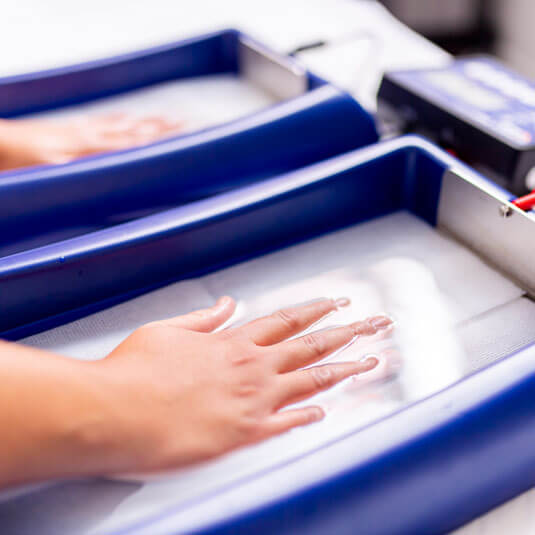Specialist Dermatology Solutions for Treatment of Hyperhydrosis of Hands: Comprehensive Overview
Unveiling the Complexities of Excessive Sweating: A Comprehensive Guide to Diagnosis and Management
Excessive sweating, medically called hyperhidrosis, is a problem that affects a considerable variety of people and can have an extensive impact on their high quality of life. While sweating is an all-natural bodily feature, its overactivity in hyperhidrosis offers an unique set of difficulties that often surpass simple discomfort. Recognizing the underlying reasons, identifying the signs and symptoms, and navigating the diagnostic process for hyperhidrosis can be intricate tasks. In this extensive guide, we will certainly discover the intricacies of hyperhidrosis, from its medical diagnosis to the selection of therapy options offered, clarifying effective management approaches for those grappling with this condition.

Comprehending Hyperhidrosis Causes
Hyperhidrosis triggers can be connected to different factors such as genes, hormonal inequalities, and particular medical conditions. Genes play a significant duty in primary focal hyperhidrosis, where people acquire the condition from their household members. By recognizing the certain elements contributing to too much sweating, healthcare companies can tailor treatment strategies to resolve the underlying cause, supplying relief and enhancing the quality of life for individuals impacted by hyperhidrosis.
Identifying Hyperhidrosis Effects

Furthermore, hyperhidrosis signs may manifest in psychological and social distress, as people may really feel self-conscious or nervous about their sweating, leading to evasion of social circumstances (Treatment for hyperhydrosis of hands). Furthermore, repeated episodes of too much sweating can lead to skin maceration, fungal infections, and an overall decline in self-confidence
Diagnostic Refine for Hyperhidrosis
Starting the diagnostic process for extreme sweating involves extensive assessment of the person's case history and checkup. Asking about the start, period, and activates of sweating episodes is important to differentiate between key focal hyperhidrosis and secondary generalised hyperhidrosis. Medical history needs to also consist of inquiries about drugs, clinical conditions, and family members history of hyperhidrosis.
Throughout the physical exam, certain attention is paid to the areas impacted by sweating. The healthcare supplier might assess the extent of sweating, look for indicators of underlying conditions, and examine the effect of sweating on the person's lifestyle. Additionally, certain examinations like the gravimetric test, starch-iodine examination, or skin conductance dimensions might be carried out to quantify the amount of sweat generated.
Moreover, in situations where secondary hyperhidrosis is presumed, added examinations such as blood tests, urine tests, and imaging research studies might be advised to identify the underlying source of extreme sweating. The diagnostic procedure aims to precisely determine the type and root cause of hyperhidrosis to assist ideal management approaches.
Therapy Choices for Hyperhidrosis
When resolving excessive sweating, different therapy options are available to alleviate symptoms and boost the individual's quality of life. The treatment strategy for hyperhidrosis relies on the seriousness of signs and the individual's reaction Exessive Sweating to first therapies.
Topical treatments, such as aluminum-based antiperspirants, are often recommended as the very first line of defense for handling moderate cases of hyperhidrosis. These items work by connecting the sweat air ducts, hence reducing the quantity of sweat that gets to the skin's surface. For individuals with more extreme signs and symptoms, oral medicines like anticholinergics may be suggested to assist lower sweating. Nonetheless, these medicines can have side impacts and are not suitable for every person.

Effective Monitoring Strategies
To effectively handle hyperhidrosis, a personalized and thorough treatment strategy customized to the patient's certain demands and response to previous therapies is essential. Iontophoresis, including the usage of a reduced electrical present to minimize sweat gland activity, can be valuable for both palmoplantar and axillary hyperhidrosis. A multidisciplinary method including skin doctors, primary care medical professionals, and, if needed, doctors, can optimize the administration of hyperhidrosis.
Verdict
In final thought, hyperhidrosis is a condition characterized by too much sweating, which can considerably impact an individual's top quality of life. With proper medical diagnosis and administration methods, people enduring from hyperhidrosis can find relief and improve their general well-being.
Extreme sweating, medically known as hyperhidrosis, is a condition that impacts a significant number of individuals and can have an extensive effect on their top quality of life. By recognizing the certain elements contributing to extreme sweating, healthcare service providers can customize treatment plans to resolve the underlying cause, offering alleviation and improving the high quality of life for individuals impacted by hyperhidrosis.
Hyperhidrosis, characterized by too much sweating beyond what is needed for regulating body temperature level, can considerably influence an individual's top quality of life. Inquiring concerning the onset, period, and triggers of sweating episodes is critical to distinguish in between primary focal hyperhidrosis and additional generalised hyperhidrosis. Treatment for hyperhydrosis of hands and feet.In final thought, hyperhidrosis is a problem defined by too much sweating, which can considerably influence an individual's quality of life